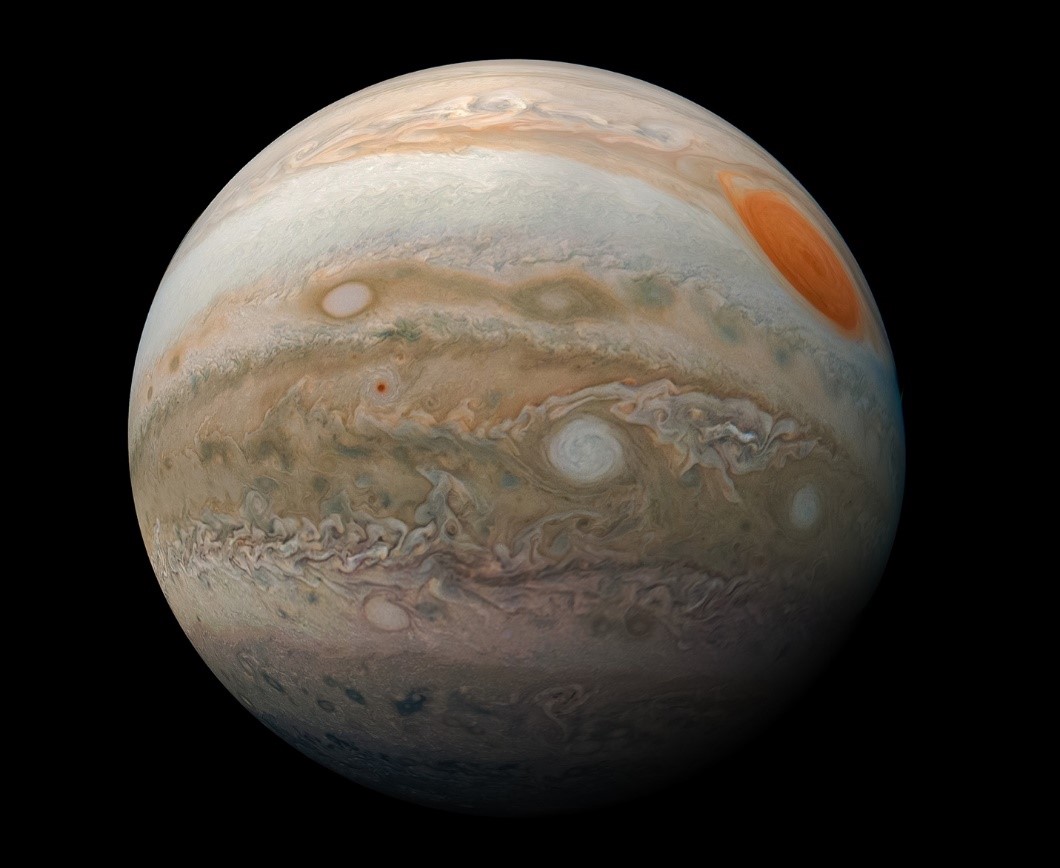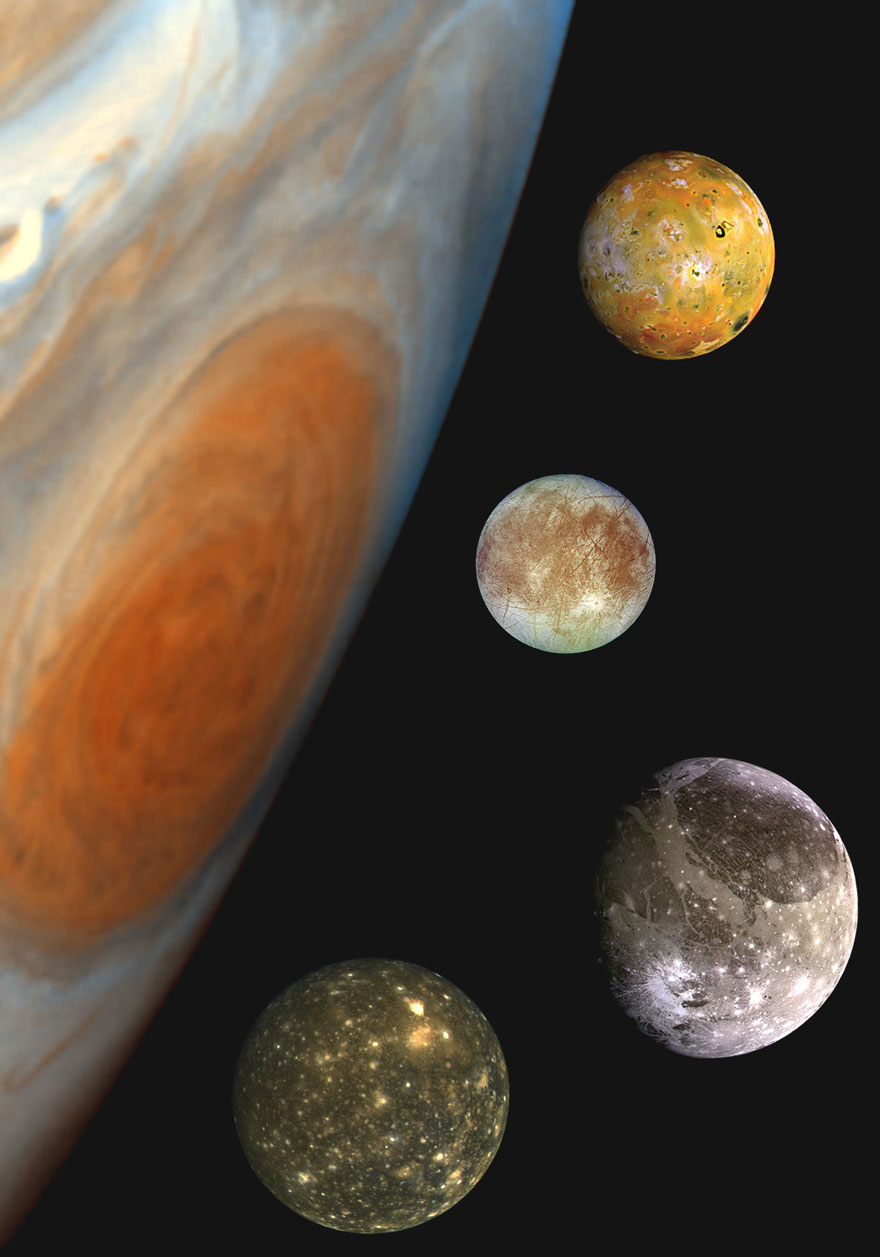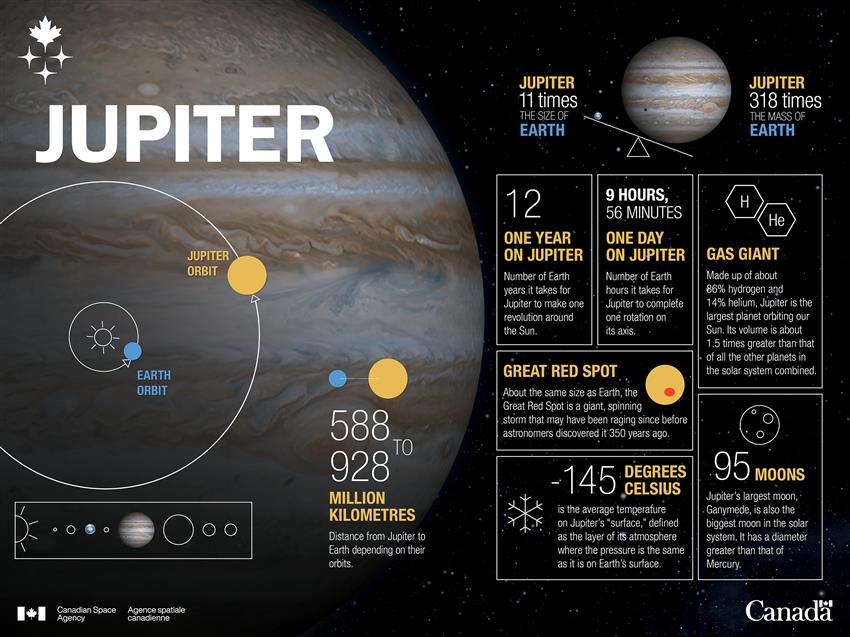Jupiter
About Jupiter
| Type | Gas giant |
|---|---|
| Size (diameter) | 139,822 km, or about 11 Earths |
| Mass | 1.9 × 1027 kg, or 318 Earths |
| Length of a year (orbital period) | 11.8 years |
| Number of moons | 79 |
| Average distance from the Sun | 778.6 million km |
| Temperature | Between -161 and -108 degrees Celsius |

A view of Jupiter, including its Great Red Spot and several other storms in its atmosphere, taken by the Juno probe in . (Credit: NASA)
Formation
Jupiter is the fifth planet from the Sun and also the largest in our solar system. Like all the other planets, it was likely formed in a massive, ancient cloud of gas, dust, and ice that collapsed into a spinning disc. Our Sun was born at its centre, and the planets were created about 4.5 billion years ago from particles sticking together along rings in the disc.
Scientists believe that many rocky planets larger than Earth existed in the early inner solar system. Physical forces moved Jupiter closer to the Sun and destroyed these other planets, allowing the formation of the current rocky planets (Mercury, Venus, Earth and Mars) before pushing Jupiter back outwards to its current position.
Jupiter has at least 79 known moons, which were drawn by the massive planet's strong gravitational pull. Fifty-three of them have names, while 26 are not yet named.
Orbit
Jupiter has the shortest day of any planet in the solar system: it completes a full rotation on itself in less than 10 hours. Because of its very fast rotation, Jupiter is noticeably flattened at its poles and bulges around its centre.
Although Jupiter's days are short, its years are long – the planet completes an orbit of the Sun in just under 12 Earth years.
Atmosphere and surface
Since Jupiter and Saturn are mainly composed of gases instead of solid elements, it can be tricky to determine where their atmosphere ends and their surface begins. However, the surface is defined as the layer with atmospheric pressure equal to that at sea level on Earth.
Jupiter's atmosphere is very thick and is mostly composed of molecular hydrogen, helium and methane. Cloud layers and swirling storms can be seen clearly in its atmosphere, even with amateur telescopes. One storm, known as the Great Red Spot, has been observed by astronomers for centuries. It is several times bigger than Earth and appears to be shrinking.
Scientists believe Jupiter may have a small rocky core that could be about the size of Earth, but this has not yet been proven.

Seen in this composite image, the four largest moons of Jupiter are (from top to bottom) Io, Europa, Ganymede and Callisto. (Credit: NASA)
Galilean moons
The famous Italian astronomer Galileo Galilei studied Jupiter extensively in the s and discovered its four largest moons: Io, Europa, Ganymede and Callisto.
These moons are unique and of great interest to scientists:
- Io is the most volcanically active body in the entire solar system.
- Europa is an ocean world covered by a thick crust of ice. It is one of the best candidates for finding extraterrestrial life in our solar system.
- Ganymede is huge – it's even larger than the planet Mercury – and is the only moon known to have its own magnetic field.
- Callisto has the oldest and most heavily cratered surface in the solar system, which acts as a great time capsule for the history of the solar system.
Galileo's observation that these moons orbit Jupiter provided evidence against the previously held belief that all bodies in the solar system orbit Earth. Today, we know that the reverse is true. If the Galilean moons orbited the Sun, they would be large enough to qualify as dwarf planets.
Exploring Jupiter
The first spacecraft to orbit the solar system's biggest planet was NASA's Galileo in . The probe collected data about Jupiter for over seven years, which helped astronomers study several of its moons and better understand the planet's atmosphere. Galileo even observed a comet crashing into Jupiter's atmosphere in .
NASA's Juno spacecraft was launched to Jupiter in and arrived in a polar orbit around the planet in . While passing over the planet's north and south poles, the mission has returned breathtaking images of Jupiter from a new point of view and allowed scientists to learn more about the massive planet's composition and gravitational and magnetic fields.
Both the European Space Agency and NASA are designing proposed missions that might visit Jupiter's moons in the next decade to find out if they hold liquid oceans—and maybe even life.

Text version - Jupiter in numbers – infographic. (Credit: CSA)
